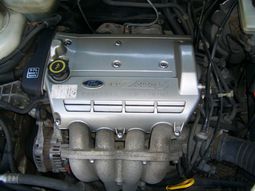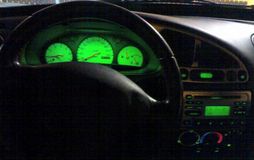The History Of FORD PUMA

The Ford Puma was a small coupé produced by the Ford Motor Company from 1997 to 2002, for sale in Europe. The Puma was solely built at Ford's Niehl plant in Cologne, Germany.
All Pumas were front-engine, front-wheel-drive, 3-door (driver, passenger and rear hatchback) coupés with 2+2 seating. Typically they had 15-inch alloy wheels, and front disc and rear drum brakes.
Puma came in four versions over the years: 1.4 (90 bhp), 1.6 (103 bhp), 1.7 VCT (125 PS), and 1.7 Ford Racing VCT (155 PS) each of which powered by Ford's 16v Sigma engines branded as Zetec-S. The car was based on the Ford Fiesta with new engines (from Yamaha), a new body and modified suspension, as well as other changes. 1.7 Pumas came with Ford's Variable Camshaft Timing (VCT) system, and both low speed TCS (traction control system) and ABS (anti-lock brakes system), 1.4 Pumas had an option of anti-lock brakes.
Weighing approximately 1,050 kg (2,293 lb), the relatively decent amount of power was sufficient to give the car exciting performance.[citation needed] The 1.7 version accelerated from 0 to 62 mph (0 to 100 km/ h) in 8.8 seconds, and could accelerate from 30 to 70 mph (48 to 112 km/ h) in 8.8 seconds.
Ford Racing Puma
The Ford Racing Puma was created by the Ford Rally specialist team at Boreham, lead by Peter Beattie. The production run was initially pencilled to run for 1000 units, 500 destined for the German market, 500 for the UK. All conversions were carried out by Tickford, Daventry UK. The vehicle featured a modified version of the 1.7 Zetec-S engine which produced 155bhp and 119 lbs/ ft of torque. It could also accelerate to 62mph in 7.9 seconds. As well as this there were other modifications including wider bodywork and track front and rear, disc brakes to the rear and larger race-spec Alcon discs/ 4 pot calipers up front, Sparco bucket seats, blue Alcantara trim, 17" Speedline rims. Ultimately, Racing Puma was only sold in the right-hand drive format to the UK market. All were produced in Ford Racing Blue paint, (same as the paint used on Focus RS), which was otherwise not available on Pumas in the UK market. Less than half were actually sold to customers due to the vehicle's high price/ bhp often cited as a reason for this. The lower than anticipated demand saw Ford offering Racing Pumas to senior managers through their MRC scheme, which enabled cars to continue being registered and converted.[citation needed]
Kit Car variant
Ford also produced a Ford Puma Kit Car which was designed to be competed in rallying. The Puma's technical details: Engine Zetec SE all alloy, 4 cylinders, 16 valves, 1596 cc. Power Over 200bhp (150kW) at 9000 rpm. Transmission Front wheel drive via Hewland 6-speed sequential gearbox. Limited slip differential. Suspension Front: Dynamic suspension MacPherson struts with adjustable spring platforms. Rear: Ford Racing trailing arm beam with adjustable dynamic suspension Brakes Front: Alcon 355mm (14.0in) diameter ventilated discs with four piston callipers
Rear: Alcon 260mm (10in) diameter solid discs with two piston callipers.
Body Shell Welded steel safety roll cage. Front and rear wheel arches and bumpers in composite. Fuel Tank 55 Litre capacity FIA ‘bag’ tank located beneath rear floor. Wheels Tarmac: 7” x 17” aluminium wheels. Gravel: 6” x 15” aluminium wheels.
2008 will see Luke Pinder contest the R2 class of the British Rally Championship in a Ford Puma
Stylistically, the Puma followed Ford's New Edge design strategy, as first seen in the 1996 Ford Ka. While not as controversial as the Ka when it first appeared, the Puma did achieve critical acclaim for its well-proportioned and cat-like design cues.
The Puma was memorable for its launch campaign that featured Steve McQueen. The original UK television advertisement used clips from the movie Bullitt and cut McQueen into the modern setting of a Puma in San Francisco. In late 2004, Ford once again used the McQueen footage for the first 2005 Ford Mustang commercial in the U.S.
The Puma was only sold in Europe and was discontinued in 2002. Ford did not replace it with another small coupé, and instead introduced the Ford StreetKa, a two-seater convertible based on the Fiesta just as the Puma was. The StreetKa also borrowed the Puma's transmission and suspension.
A new Ford Puma is rumored to be launching in 2009, a year after the new Fiesta based on the Reflex concept car shown in the Detroit Motor Show in 2006. A new Capri will follow in 2010.
- Puma was named Top Gear's car of the year for 1997 for the incredible feeling and driving sensation.
- 2001 - What Car's Used Sports Car Of The Year- Ford Puma 1.7
- 2004 - What Car's Best Used Sporting Car of the Year Under £10,000 - Ford Puma 1.7
From Wikipedia, the free encyclopedia
More About FORD PUMA



|